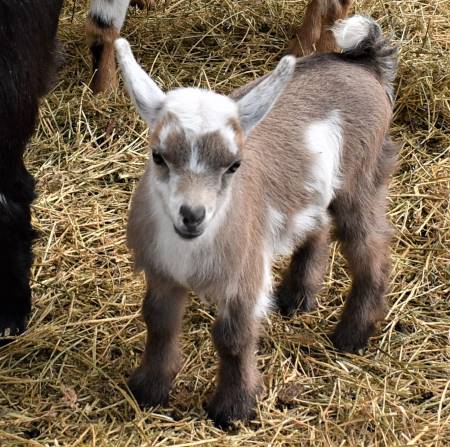Pregnant Does: Hypocalcemia (Milk Fever)
Periparturient Hypocalcemia (Milk Fever)
by: Robert Van Saun, DVM, MS, PhD Department of Veterinary Science Pennsylvania State University
Hypocalcemia (low blood calcium concentration) is a disease commonly seen in dairy cattle on or immediately following calving. Sheep can experience hypocalcemia during late pregnancy associated with rapid calcium loss to the developing fetus for bone mineralization. Other species can experience hypocalcemia at or near the time of peak lactation (lactational eclampsia). Based on limited information available regarding goats, it seems dairy breed goats are potentially prone to all three manifestations of hypocalcemia.
Clinical Signs. Initially the doe is ataxic, nervous and hyperactive. The doe is hyperirritable and may show muscle twitching of the lips, eyelids and ears. Trembling or twitching of other muscles of the body may also occur. Convulsions may develop. The doe quickly becomes sternally recumbent and laterally recumbent in the final stages. The head may be turned back to the flank. Less severely affected does (subclinical hypocalcemia) show lethargy, poor appetite and poor milk production. Affected does stop eating and their ears and skin are cold to the touch. Body temperature will initially be slightly elevated, but will decline to subnormal in a short period of time. Pupils are dilated and respond very slowly or not at all to a flashlight being shone directly at them. Sometimes the hind legs are splayed out behind the doe. The heart is very hard to hear or feel and beats rapidly and weakly. Death follows bloat, regurgitation of rumen contents and aspiration. The disease course can be as short as a few hours or occur over a couple of days. Occasionally it may occur as "sudden death"; the doe is found dead in the morning. Serum calcium levels are decreased, usually less than 6 mg/dl (normal 8 - 12 mg/dl). To help in diagnosing hypocalcemia in a sudden death case, fluid from eye chambers obtained during a postmortem examination can be analyzed for calcium concentration up to 48 hours after death. Hypocalcemia may look like other diseases and the doe must be examined by a veterinarian in order to differentiate from polioencephalomalacia, advanced grain overload, toxic mastitis, lead poisoning and listeriosis. Hypocalcemia is often a secondary complicating factor with pregnancy toxemia and ketosis.
Causes. Much research has been done on hypocalcemia in dairy cows and this information is often extrapolated to dairy goats. Dairy cows experience a decline in blood calcium concentration on the day of calving, associated with colostrum production and reduced intake. If the normal homeostatic system is dysfunctional, blood calcium concentration will remain low following calving and result in milk fever syndrome. It is thought that either high calcium intake during pregnancy or high cationic diets (high in potassium, sodium, calcium) suppress the homeostatic system. In contrast, sheep experience hypocalcemia during late pregnancy as a result of insufficient dietary calcium to meet fetal needs. Insufficient calcium intake during late pregnancy or early lactation will require the body to mobilize calcium from bones to meet the need. If the hormonal mechanisms are not properly prepared, mobilization will be delayed and low blood calcium concentration will result. The dairy goat capable of heavy lactation and pregnant with multiple fetuses seems a prime candidate for hypocalcemia at any of the time periods seen with other species.
Treatment. Clinical cases of hypocalcaemia are usually treated with careful intravenous calcium borogluconate solution infusions. This may be followed by subcutaneous injections of calcium solutions as well as oral supplements. Less severely affected does can be treated with just subcutaneous solutions. Response to intravenous treatment should be dramatic. The doe usually starts to shiver and brightens up by the time treatment is finished. If she does not, it may be the diagnosis is incorrect or is complicated by another disease. It is important that intravenous treatment only be given in the face of strong clinical evidence of disease. Calcium can easily cause death if given intravenously to an animal with normal calcium levels. Following intravenous or subcutaneous injections, dietary intake of calcium should be increased with use of alfalfa hay or calcium-based mineral supplements.
Prevention. Without good scientific evidence describing the mechanism responsible for hypocalcemia in dairy goats, it is difficult to define specific feeding recommendations. It would seem prudent to maintain appropriate dietary calcium and phosphorus content in late pregnancy to support fetal bone development, but not to supplement to excess. Dietary potassium should be monitored in an attempt to maintain a level below 2%. Dietary magnesium should also be monitored and maintained according to dietary potassium (see next section on hypomagnesemia).
Once into lactation, dietary calcium and phosphorus content should be increased to a level to support milk production capacity. Alfalfa hay can provide this. Cereal crop forages such as wheat or oat hay are very low in calcium (0.15% and 0.24% dry matter (DM) basis respectively) as opposed to alfalfa hay (1.4% DM) and should be avoided unless the ration is balanced with other calcium sources. Use of anionic salts (minerals high in chloride and sulfur) has been advocated for dairy cattle in preventing milk fever. This requires specialized feed ingredients to be fed and close monitoring as well as controlling dietary potassium content. In using anionic salts, the goal is to induce a state of compensated metabolic acidosis, which stimulates calcium absorption and mobilization. To achieve the desired effect, one must ensure the animal is appropriately acidified. Urine pH measurements are used for this purpose. In general, anionic salt feeds are not very palatable and can reduce feed intake. This is an undesirable effect. Also these products are only to be fed for a brief period of 10-14 days immediately prior to calving. At present, there seems to be little information to support use of such a control method in goats. In selected situations where hypocalcemia is a serious problem, then with veterinary guidance, this approach may be warranted.
Additional Information:
What is Hypocalcemia in Goats?
HYPOCALCEMIA IN GOATS IS A CALCIUM DEFICIENCY.
-
Prevention is key:
There is a strong correlation between how well we feed our animals and their health!
Calcium is abundant in alfalfa. Start giving your goat alfalfa hay around the 90-day mark and continue to give her alfalfa hay during the duration of her lactation. -
Symptoms to watch for:
apparent weakness.
Decreased appetite
Mild bloat or constipation
Doe wobbly on her feet.
Inability to stand.
trembling in the muscles
Weakened uterine contractions
Decreased body temperature.
The doe may stop ruminating, urinating, or defecating.
Shivering after milking -
Treatment: In mild cases CMPK is a product that contains calcium as well as magnesium, phosphorus, and potassium, all of which makes the calcium more readily available for the body to use. The calcium will be utilized much quicker and the doe will return to health faster.
-
Important: get to the Vet to get the blood test done first if at all possible. The blood test will reveal just how low your goat's calcium is and what treatment needs to follow. The most effective treatment for very low calcium is the administration of an IV calcium supplement which must be given by your Vet.
You will then want to treat her in this fashion or according to your Vet's recommendation: -
Use a product called CMPK DURVET 067645 Cmpk Gel, 300ml Other options are CMPK in the bolus form Cmpk Bolus 50 Ct
-
CMPK is a product that contains calcium as well as magnesium, phosphorus, and potassium, all of which makes the calcium more readily available for the body to use. The calcium will be utilized much quicker and the doe will return to health faster.
-
This treatment will need to be given until the doe has reached optimal health and is being fed a sufficient calcium-filled diet. If only one dose is given, it will balance her levels of calcium only for the moment. As the babies continue to grow, they will drain her system and her levels will once again drop and the problem will persist.



Powered by Boutique Store Builder . Web Design by Avalon Rose Design.


